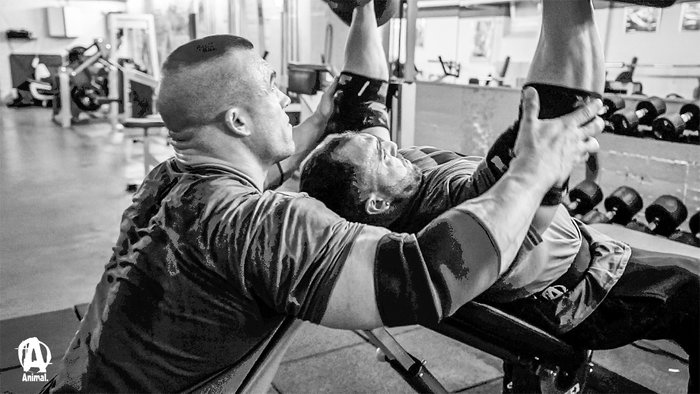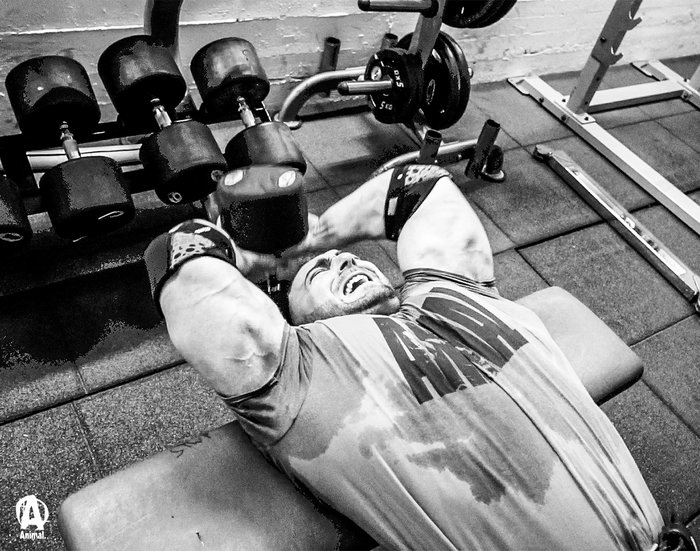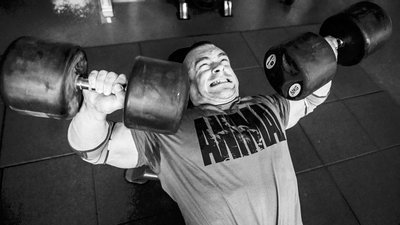Amateur bodybuilder Vincenzo "MASS" Masone and IFBB pro Roman "Rex" Fritz first tackled a grueling back-and-chest workout in Roman's hometown of Cologne, Germany.
If you saw that workout ("Get Thicker and Wider: The Hardcore Chest-And-Back Workout") you know these two both need to buy knee sleeves to fit their elbows.
Translation? When it comes to putting on size, these boys don't mess around.
Do you need to watch Part 1 to fully appreciate this second installment? It helps, but this workout is a stand-alone beast with no need for a prequel.
Enter the Dungeon
This time around, Masone returns the favor by leading Roman through a chest workout in his home gym, a basement called The Dungeon, on Long Island, New York. These two Animals have hit the gym together three times now, but can an amateur NPC competitor challenge an IFBB pro? Anyone who has met Roman knows he can withstand a ton of abuse, but Masone is considerably larger than Roman, so it's tough to predict if the weight difference will come in to play.
A Strength vs. Endurance Challenge
Roman, in typical heavy-volume fashion, usually warms up to his working weight, then performs all his working sets with it—regardless of rep range. He favors the German-style higher volume, quick pace, and short rests.
Masone, by contrast, uses heavier weight with fewer sets and reps, a slower tempo, and longer rest periods. To match Roman's brutal workout in Cologne—a marathon 10 sets of 10 reps—Masone sets up a 5-exercise, pyramid-style workout, decreasing the reps with every increase in weight.
This approach, based on experience, works well with Masone's physique and temperament.
They begin with a lighter, 80-pound set of incline dumbbell presses in the 15-20 rep range as their first working set.
"Of course it's a little different for me," says Roman. "Normally, I'm not one to pyramid with weight. I just warm up until I get to my working weight—so I get a different kind of stimulus today."
The second set is a little heavier, in the 12-15 rep range. Finishing the pyramid in the 6-8 rep range, Roman and Masone continue this pattern for the following three exercises.

Which Style Reigns Supreme?
Based on their divergent workout styles, this session provides a nearly perfect endurance versus strength match-up, leaving only one question: Who will prevail?
Not surprisingly, each man found equal footing within his own comfort zone. Roman hit higher reps than Masone on the lighter weights, but Masone could go higher than Roman on the heavier weights.
How could two different styles meet so perfectly in the middle? It all boils down to how each one trains. One trains high rep, high volume, little rest, while the other chases higher weight, lower reps, and more recovery.
"I'm built more for endurance, while he's built more for strength," Roman explains.
Switch It Up and Increase Gains
The important takeaway in this head-to-head, endurance-versus-strength battle is each competitor acknowledging he can learn from the other. Roman believes he can benefit from adding low-rep sets in his future training sessions. For his part, Masone saw the need for incorporating higher rep sets to build better roundness and refinement in his tissues.
"Everyone should do what's best for them," says Roman, "but it is never wrong to change up your workout if it changes up and improves your development."
Masone always thought that lower weight and higher reps would cause him to lose mass. Since incorporating more of Roman's training style, however, he's noticed that his weight is still going up but he's leaning out with some noticeable striations in his abs.
"I wish I could make this guy my training partner every day," says Masone, "as fucking crazy as that sounds. It pushes me!"
Neither type of training is better than the other. It's a matter of personal preference, body type, and goals. You must find what works best for you.
But as the mash up of these two workouts shows, it's never wrong to mix things up. Change and variety will always improve your development. The approach to making gains is very simple—change the stimulus, get uncomfortable, and chase the pain.
Always chase the pain.
Masone's "Chase the Pain" Chest Workout
Incline dumbbell press

- Warm up 60 lbs. for 20 reps
- 80 lbs. for 20 reps
- 110 lbs. for 15 reps
- 120 lbs. for 10 reps
- 130 lbs. for 10 reps
"Grip the dumbbells as tight as possible and exhale as you press upward," says Masone. "I always try and keep my elbows in a straight line when I press. Extend up to the point just before the dumbbells touch. This keeps tension on my upper pecs."
Cable crossover

- 50 lbs. for 15 reps
- 100 lbs. for 12 reps
- 150 lbs. for 10 reps
"I always picture myself on stage hitting my most-muscular pose when I do cable crossover," says Masone. "Let the weight stretch out your pecs as you open up, then squeeze together and try to touch your thumbs when you pull down. Hold for a few seconds at the midpoint."
Floor press
- 110 lbs. for 15 reps
- 110 lbs. for 15 reps
- 80 lbs. for 15 reps
"Floor presses don't allow your elbows to pass your chest, which reduces your chance of injury. So they're good if you have elbow pain," says Masone. "When fully extend, hold at the top and squeeze your pecs together."
Flat bench press
- 135 lbs. for 20 reps
- 135 lbs. for 20 reps
- 225 lbs. for 12 reps
"As you can see in this video, Roman or I did not go over 225 pounds on the flat bench," says Masone. "We each let the weight rest on our chest for a few seconds before slowly finishing the movement. If you do these very slowly, with a negative and a slow push, I guarantee 225 will feel like 500."
Dumbbell pull-over

- 80 lbs. for 3 sets of 12-15 reps
"I now call Roman's version "German-style" pull-overs, in honor of him," says Masone. "Keep your hips and head down. Breathe in while lowering the dumbbell. Exhale fully while pulling the dumbbell back up to the starting point."




